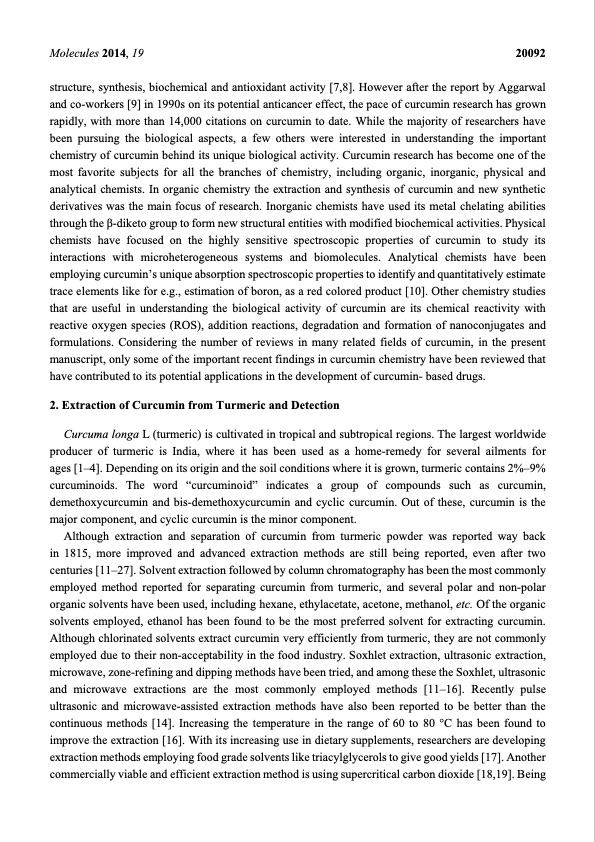
PDF Publication Title:
Text from PDF Page: 002
Molecules 2014, 19 20092 structure, synthesis, biochemical and antioxidant activity [7,8]. However after the report by Aggarwal and co-workers [9] in 1990s on its potential anticancer effect, the pace of curcumin research has grown rapidly, with more than 14,000 citations on curcumin to date. While the majority of researchers have been pursuing the biological aspects, a few others were interested in understanding the important chemistry of curcumin behind its unique biological activity. Curcumin research has become one of the most favorite subjects for all the branches of chemistry, including organic, inorganic, physical and analytical chemists. In organic chemistry the extraction and synthesis of curcumin and new synthetic derivatives was the main focus of research. Inorganic chemists have used its metal chelating abilities through the β-diketo group to form new structural entities with modified biochemical activities. Physical chemists have focused on the highly sensitive spectroscopic properties of curcumin to study its interactions with microheterogeneous systems and biomolecules. Analytical chemists have been employing curcumin’s unique absorption spectroscopic properties to identify and quantitatively estimate trace elements like for e.g., estimation of boron, as a red colored product [10]. Other chemistry studies that are useful in understanding the biological activity of curcumin are its chemical reactivity with reactive oxygen species (ROS), addition reactions, degradation and formation of nanoconjugates and formulations. Considering the number of reviews in many related fields of curcumin, in the present manuscript, only some of the important recent findings in curcumin chemistry have been reviewed that have contributed to its potential applications in the development of curcumin- based drugs. 2. Extraction of Curcumin from Turmeric and Detection Curcuma longa L (turmeric) is cultivated in tropical and subtropical regions. The largest worldwide producer of turmeric is India, where it has been used as a home-remedy for several ailments for ages [1–4]. Depending on its origin and the soil conditions where it is grown, turmeric contains 2%–9% curcuminoids. The word “curcuminoid” indicates a group of compounds such as curcumin, demethoxycurcumin and bis-demethoxycurcumin and cyclic curcumin. Out of these, curcumin is the major component, and cyclic curcumin is the minor component. Although extraction and separation of curcumin from turmeric powder was reported way back in 1815, more improved and advanced extraction methods are still being reported, even after two centuries [11–27]. Solvent extraction followed by column chromatography has been the most commonly employed method reported for separating curcumin from turmeric, and several polar and non-polar organic solvents have been used, including hexane, ethylacetate, acetone, methanol, etc. Of the organic solvents employed, ethanol has been found to be the most preferred solvent for extracting curcumin. Although chlorinated solvents extract curcumin very efficiently from turmeric, they are not commonly employed due to their non-acceptability in the food industry. Soxhlet extraction, ultrasonic extraction, microwave, zone-refining and dipping methods have been tried, and among these the Soxhlet, ultrasonic and microwave extractions are the most commonly employed methods [11–16]. Recently pulse ultrasonic and microwave-assisted extraction methods have also been reported to be better than the continuous methods [14]. Increasing the temperature in the range of 60 to 80 °C has been found to improve the extraction [16]. With its increasing use in dietary supplements, researchers are developing extraction methods employing food grade solvents like triacylglycerols to give good yields [17]. Another commercially viable and efficient extraction method is using supercritical carbon dioxide [18,19]. BeingPDF Image | Curcumin: From Extraction to Therapeutic Agent

PDF Search Title:
Curcumin: From Extraction to Therapeutic AgentOriginal File Name Searched:
molecules-19-20091.pdfDIY PDF Search: Google It | Yahoo | Bing
CO2 Organic Rankine Cycle Experimenter Platform The supercritical CO2 phase change system is both a heat pump and organic rankine cycle which can be used for those purposes and as a supercritical extractor for advanced subcritical and supercritical extraction technology. Uses include producing nanoparticles, precious metal CO2 extraction, lithium battery recycling, and other applications... More Info
Heat Pumps CO2 ORC Heat Pump System Platform More Info
| CONTACT TEL: 608-238-6001 Email: greg@infinityturbine.com | RSS | AMP |